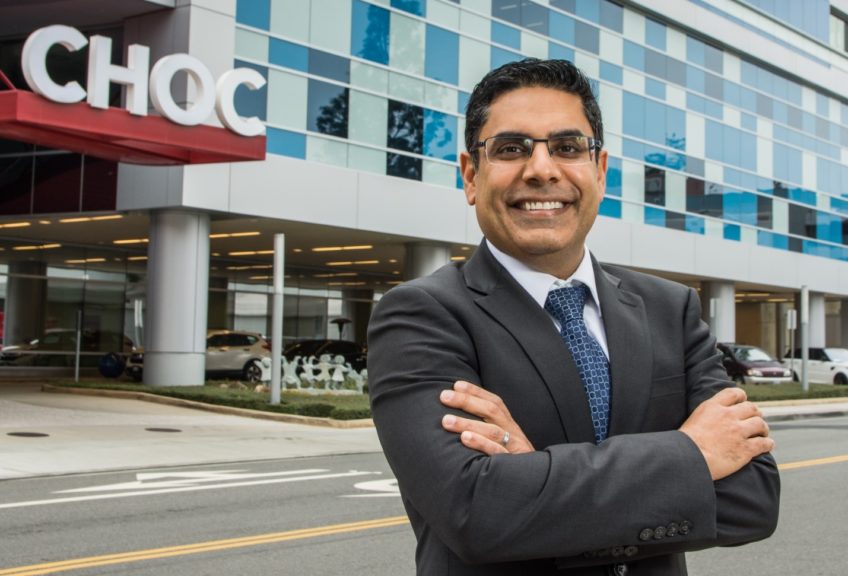Ophthalmology might not be the first specialty that comes to mind when envisioning a telehealth practice, but Dr. Rahul Bhola, medical director of ophthalmology at CHOC, has seamlessly integrated the service in his practice, completing more than 900 telehealth visits since March.
In this Q & A, Dr. Bhola outlines his team’s success in transitioning to telehealth, and shares best practices that physicians in a variety of specialties can put into practice:
What does an ophthalmology telehealth appointment look like?
A synchronous (live audio-video) CHOC ophthalmology telehealth appointment is divided into four components. I call them the four C’s: contact, connect, consult and care.
- Contact
Our front desk reaches out to the family to confirm contact information. We send a Zoom link to the families, along with information about how to connect to Zoom and download the visual acuity app to check vision before the appointment. - Connect
As the appointment day approaches, our technician connects with the family to discuss any technical issues that should be resolved prior to the physician consultation. The technician also goes over the at-home visual acuity check and evaluates basic medical history. - Consult
On the actual day of the appointment, the physician connects with the families on Zoom to go over the pertinent history and visual acuity, and performs a focused examination including an external and ocular motility exam. If needed, pictures and videos from the family are requested for further evaluation. This enables us to diagnose a majority of anterior segment ocular issues as well as visual acuity concerns like amblyopia, refractive errors and ocular motility disorders. - Care
We discuss the treatment care plan and review any medical issues or concerns the patient is experiencing. Throughout this process, we can fulfill their needs ranging from prescription refills for medication or broken glasses without them having to step outside the comfort of their home.
Our office will then schedule a follow-up visit depending on the medical necessity.

How do your patients and families feel about telehealth?
While some physicians may have been wary of telehealth care, I was pleasantly surprised that patients love telehealth.
Telehealth helped our patients and families feel secure, supported and assured that there would be no interruption in the patient’s care plan during COVID-19. Our families are so grateful that during this time of emergency, their physician was able to connect with them to address any urgent issues and follow them in clinic on a need-to basis.
Due to the positive response we have received from our families, we will continue to offer telehealth visits for our families, when appropriate.
Does telehealth compromise quality of care?
Not at all. Providers are often able to spend more time with patients during a telehealth visit. Children are more comfortable in their home setting and you can engage more with them and spend more time on-screen with them.
If we felt the urgency to see our patients face-to-face after the initial exam, we schedule in-person appointments.
What makes your telehealth visits successful?
The expression “Necessity is the mother of invention” really is true when it comes to telehealth. Telemedicine has been around for a while, but it took a pandemic to make it universal and successful. As soon as the stay-at-home orders were announced we knew we had to connect with our patients to prevent any disruption of their care. Our team was not afraid of change and we realized the urgency to adapt to the circumstances right away to provide uninterrupted care to our patients and their families. We reallocated our resources to maximize our outreach; our goal was to connect with each and every patient scheduled to be seen in the clinic.
What advice and tips do you have for other providers to do telehealth successfully?
Being open minded, adaptable to the changing circumstances and embracing technology were a few things that helped us during this unprecedented time. We created a vigorous team of both technical and non-technical staff in a short span of time to enable successful initiation of a robust tele-ophthalmology program. The key was strategizing dynamically in this constantly changing environment and having frequent huddles with the team to address any issues.
Very quickly we realized that telehealth was amazing to address the four-part aim of healthcare: access, cost-effectiveness, patient satisfaction and physician satisfaction.
There will be nuances for specific specialties. In our case the American Academy of Ophthalmology right away provided resources and tools to help us initiate an effective synchronous telehealth portal.
Technological innovations like visual acuity apps and the ocular motility app were phenomenal tools developed to assist effective consultations.




